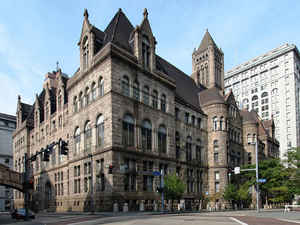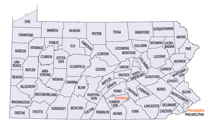Allegheny County, Pennsylvania
Allegheny County Education, Geography, and History

Allegheny County is a county in the southwestern part of the state of Pennsylvania. As of 2014 the population was 1,231,225,making it the second-most populous county in Pennsylvania, following Philadelphia County. The county seat is Pittsburgh.
Allegheny County is included in the Pittsburgh Metropolitan Statistical Area. The county is in the Pittsburgh Designated Market Area.
Etymology - Origin of Allegheny County Name
Allegheny County was the first in Pennsylvania to be given a Native American name, being named after the Allegheny River. The word "Allegheny" is of Lenape origin, with uncertain meaning. It is usually said to mean "fine river", but sometimes said to refer to an ancient mythical tribe called "Allegewi" that lived along the river long ago before being destroyed by the Lenape.
The Allegheny River, a principal tributary of the Ohio River; it is located in the Eastern United
States. The Allegheny River joins with the Monongahela River to form the Ohio River at the "Point" of Point State
Park in Downtown Pittsburgh, Pennsylvania.
Demographics:
County QuickFacts: CensusBureau Quick Facts
Allegheny County History
Created on September 24, 1788, from
parts of Westmoreland and Washington Counties and named for the Allegheny River.
General John Forbes named Pittsburgh, the county seat, in November 1758 in honor
of William Pitt, a British statesman. It was incorporated as a borough on April
22, 1794 and as a city on March 18, 1816.
The conflict between the British and French over claims in this area was settled
in 1758 when Gen. John Forbes and his British and American army forced the
French to abandon Fort Duquesne, a post they had built in 1754. The British
completed Fort Pitt in 1761. After the defeat of an Indian resurgence in 1763
and the end of a dispute for control with Virginia (1780), settlement swelled.
This was an outfitting point for settlers who rafted down the Ohio River, and
soon shipbuilding developed. A blast furnace erected by George Anshutz about
1792 began the long rise of the iron and steel industry. In 1845 a fire
destroyed one-third of Pittsburgh, but in 1852 the Pennsylvania Railroad was
opened to Philadelphia and in 1859 coke was first used in a blast furnace and
cold rolling was invented. Pittsburgh was a major manufacturing center during
the Civil War. Between 1874 and 1880 oil refineries, papermaking, and wood
products industries were pushed to other locations because products that were
made through high heat processes took over in Pittsburgh. From 1882 to 1901 the
partnership of Henry Clay Frick and Andrew Carnegie achieved world leadership in
steel. Violent labor strikes included the railroad strike of 1877, the Homestead
Steel strike in 1892, and the SWOC 1936 strike. In 1901 Carnegie sold out to the
new U. S. Steel Company. In 1920 the "value added by manufactures" figure for
Pittsburgh's industry began to decline, but from 1939 to 1954 steel experienced
a second period of grandeur. In 1946 the "Pittsburgh Renaissance" city revivals
(I and II) were first conceived. From about 1970 to the present, an era of
deindustrialization has prevailed. However, an increase of 15 percent in the
county's figure for value added from manufactures between 1987 and 1992 suggests
that the economy may have finally stabilized. The peak of Allegheny County's
population was 1,628,587 in 1960; the peak for Pittsburgh was 676,806 in
1950- and it is now only 369,879. The county has also been a major bituminous
producer, blessed with the magnificent Pittsburgh coal vein. In the last five
years subsurface mining has almost ceased. Farms still cover 9.2 percent of the
land, and Allegheny is the ninth ranked mushroom-producing county.
Geography: Land and Water
Allegheny County is known for the three major rivers that flow through it: the Allegheny River and the
Monongahela River converge at Downtown Pittsburgh to form the Ohio River. The Youghiogheny River flows into the
Monongahela River at McKeesport, Pennsylvania, 10 miles (16 km) southeast. Despite its industrial growth, much of
Allegheny County is covered with forests.
As reported by the Census Bureau, the county has a total area of 745 square miles (1,929 km2); 730 square miles
(1,891 km2) of it is land and 15 square miles (38 km2) of it (1.95%) is water.
Neighboring Counties
Bordering counties are as follows:
- Butler County (north)
- Armstrong County (tangent to the northeast)
- Westmoreland County (east)
- Washington County (southwest)
- Beaver County (northwest)
Education
Colleges and universities
The Art Institute of Pittsburgh
Byzantine Catholic Seminary of SS. Cyril and Methodius
Carlow University
Carnegie Mellon University
Chatham University
DeVry University
Duquesne University
La Roche College
Penn State Greater Allegheny
Pittsburgh Theological Seminary
Point Park University
Reformed Presbyterian Theological Seminary
Robert Morris University
University of Pittsburgh
Community, junior and technical colleges
Bidwell Training Center
Bradford School
Career Training Academy
Community College of Allegheny County
Dean Institute of Technology
Duff's Business Institute
ICM School of Business and Medical Careers
International Academy of Design and Technology
ITT Technical Institute
Le Cordon Bleu Institute of Culinary Arts in Pittsburgh
Median School of Allied Health Careers
Pittsburgh Beauty Academy
Pittsburgh Institute of Aeronautics
Pittsburgh Institute of Mortuary Science
Pittsburgh Technical Institute
Rosedale Technical Institute
Triangle Tech
Western School of Health and Business Careers







